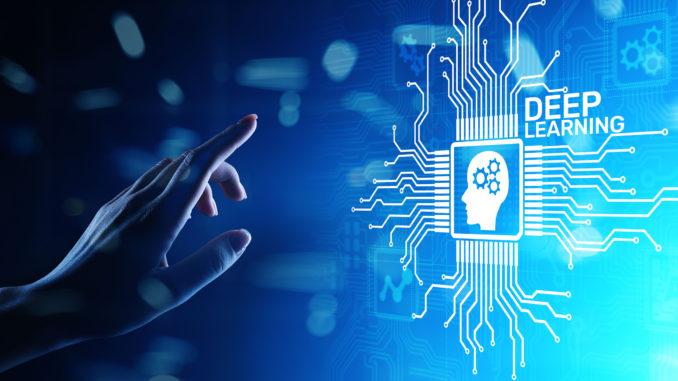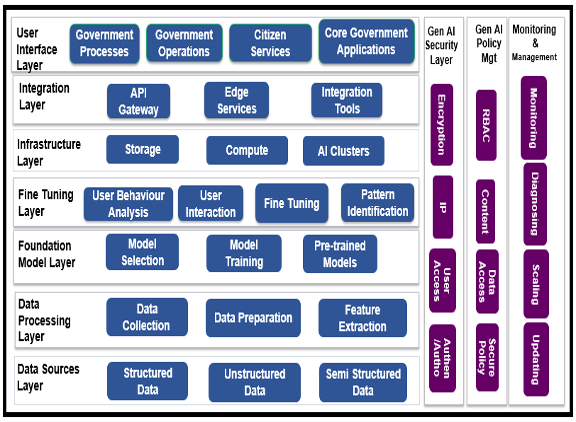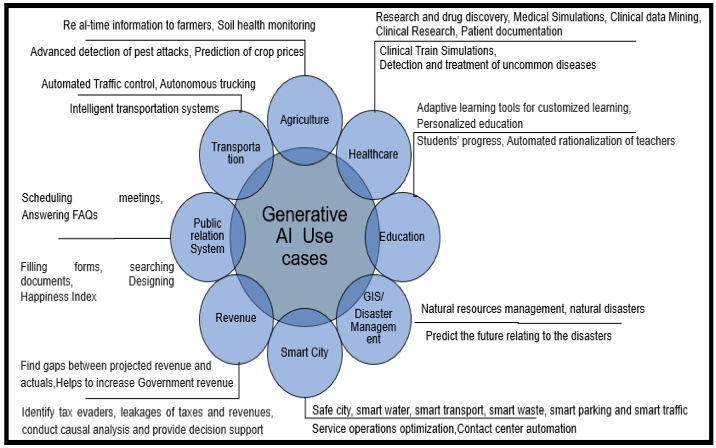
Dr. Gopala Krishna Behara & Prasad Palli
(Part 1 of this article appeared yesterday and is available here.)
Generative AI Principles of Digital Government
Generative AI encompasses the design, development, and monitoring of artificial intelligence systems to augment and enhance the productivity and quality of work across Government.
Generative AI principles and Rationale of Digital Government are described below. They help in achieving safe, more reliable and fair outcomes for all Governments.
Principle 1: People should be accountable for AI systems. Generative AI tools must not be the final decision maker on Government Services.
Rationale: Create an oversight so that humans can be accountable and in contact. Assess the impact of the system on people and governments.
Principle 2: Generative AI Systems should be transparent and understandable.
Rationale: Design Generative AI systems for the decision making by the Government to inform activities. Generative AI systems are designed to inform citizens that they are interacting with an AI system.
Principle 3: Generative AI systems should treat all citizens fairly.
Rationale: All the communications should indicate whether Generative AI was used to generate any of the information. Generative AI systems are designed to provide a similar quality of service for identified demographic groups without bias or discrimination.
Principle 4: Generative AI systems should empower everyone and engage citizens.
Rationale: Generative AI systems are designed to be inclusive in accordance with government accessibility standards
Principle 5: Design systemic data quality management.
Rationale: Train data be available for the government AI systems
Principle 6: Unify all the government data.
Rationale: Integrate data from numerous systems into a unified federated data. Data must be current and real-time.
Principle 7: Access multi format data
Rationale: The platform needs to support database technologies including relational data stores, distributed file systems, key-value stores, graph stores as well as legacy applications.
Principle 8: Systems should maintain the Privacy protection and security of sensitive information.
Rationale: All the activities need to align with government and policies relating to information and data. Sensitive information must not be entered into public Generative AI tools.
Principle 9: Human Centered Value
Rationale: Generative AI systems should benefit citizens, society and the environment. Generative AI systems should respect human rights, diversity and autonomy of citizens.
Principle 10: Provide government data governance and security.
Rationale: Generative AI platform must provide robust encryption, multi-level user access authentication, and authorization controls.
Generative AI based Government Reference Architecture
The architectural components of Generative AI for government domain may vary depending on the specific use case, but generally, it includes the following core components and layers. Every layer of Generative AI architecture is responsible for specific functions, and they all work together to create a Generative AI solution that can create something new and innovative.
The various layers of Generative AI for government are classified as,
- Data Sources Layer
- Data Processing Layer
- Foundation Model Layer
- Fine Tuning Layer
- Generative AI Infrastructure Layer
- Integration Layer
- User Interface Layer
- Security Layer
- Generative AI Policy Management
- Monitoring and Management Layer

Figure 3: Generative AI Architecture Layers
Data Sources Layer: The data sources provide the insight required to solve business problems. The data sources are structured, semi-structured, and unstructured, and they come from many sources.
Data Processing Layer: Data is a core requirement of Generative AI systems. The data processing layer of Government Generative AI architecture involves the steps covering collection, preparation and feature extraction to be used by the generative AI model.
- Data Collection: It involves gathering data from government databases, documents and emails, social media, websites and storing it in a AI data repository. It primarily consists of Model hub, blog storage and databases. Model hubs consist of trained and approved models that can be provisioned on demand and acts as a repository for model checkpoints, weights, and parameters. Comprehensive data architecture covering both structured and unstructured data sources are defined as part of repository. Also, the data is categorized and organized so that it can be used by generative AI models. Examples might be scrapping websites using API’s or reading files from storage.
- Data Preparation: It involves cleaning and normalizing the data to remove inconsistencies, errors and duplicates. The cleaned data is transformed into a suitable format for the AI model to analyze. This involves removing duplicates, correcting errors and ensuring consistency in formats and structures.
- Feature extraction: It involves identifying features or data patterns critical for the model’s performance. Feature extraction reduces the data amount while retaining the most important information for the model.
Foundation Model Layer: These are machine learning models responsible for creating new content or data.
These models can use a variety of techniques, such as deep learning, reinforcement learning, or genetic algorithms, depending on the use case and type of data to be generated.
In this step a significant amount of relevant data is used to train the model, which is done using various frameworks and tools such as TensorFlow, PyTorch and Keras. They are trained on huge quantities of unstructured and unlabeled data to perform specific tasks. To process large amounts of unstructured text the foundation models leverage Large Language Models (LLMs).
LLMs are a type of AI system trained on a large amount of text data that can understand natural language and generate human like responses. LLM models can be built using Open-Source Models or Proprietary Models. These models are classified as Off-the-Shelf Models, Fine Tune Models and Build-your-own Models.
- Off-the-Shelf Models are easy to use as they are, but needs huge customization based on business needs.
- Fine Tune Models are pre-trained models enabled with specific data through fine tuning.
- Build-your-Own Models are developed from scratch based on government department specific data.
Fine Tuning Layer: The foundation models are fine tuned for domain adoption and to perform specific tasks better using short period of training on labeled data. This layer collects user feedback and analyzes the generated data to improve the system’s performance, which is crucial in fine-tuning the model and making it more accurate and efficient. The process of further training a pre-trained model on a specific task or dataset to adapt it for a particular application or domain is called Fine-Tuning.
The feedback collection process can involve various techniques such as user surveys, user behavior analysis and user interaction analysis that help gather information about users’ experiences and expectations, which can then be used to optimize the generative model. For example, if the users are unsatisfied with the generated content, the feedback can be used to identify the areas that need improvement.
Generative AI Infrastructure Layer: It consists of hardware and software components which are needed to build and train Generative AI Models. It handles storage, compute support of the vast volumes of data needed for generative AI applications. This infrastructure should be scalable to handle increasing amounts of data as the model is deployed to more users or as the data set grows. Decision about CPU/GPU/TPU are made based on requirement.
AI Search: This covers context management, caching and cognitive search. Context management provides the models with relevant information from enterprise data sources. The model provides access to the right data at right time to produce accurate output. Caching enables faster responses.
Integration Layer: This layer enables developers to build products on top of LLM models. Stakeholders use API Gateway channels to interact with government applications. It is a single point of entry for front end users to access back-end services. The service composition and orchestration based on customer journey and context. This capability is provided by API Management platforms.
GenAI Security: Helps in establishing strong security. AI security must cover strategy, planning and intellectual property. The generative AI platform needs to provide robust encryption, multi-level user access, authentication and authorization.
GenAI Policy Management: It ensures appropriate access to enterprise data assets. It covers, Role-based access control and content-based policies to secure enterprise data asset. For example, Employee compensation details covered by HR’s Generative AI models is only accessed by HR and not by the rest of the organization.
GenAI Monitoring and Management: This layer is responsible for ensuring the ongoing performance and reliability of the generative AI system, involving continuously monitoring the system’s behavior and adjusting as needed to maintain its accuracy and effectiveness.
User Interface Layer: Various stakeholders, both internal and external, will be part of this layer. They are the primary users of the systems. This layer helps create engaging and personalized experiences for users.
Real Use cases of Generative AI for Digital Government
The goal of digital governments is to establish a connected government and provide better citizen services. Generative AI enables these citizen services to deliver citizens more effectively and protect confidential information. The following is the summary of the use cases of Generative AI across all the departments of the Government.
Policy Updates and Compliance: Governments use Generative AI to automatically update policy documents, generate conforming guidelines, and revise operational manuals and websites when policies change.
AI-Powered Voice Assistants: This assistant provides proactive help with device issues over the phone, demonstrating how Generative AI can enhance public service delivery.
Regulatory Bodies: Generative AI tools are used to analyze large datasets, identify trends, and generate reports, helping regulatory bodies make informed decisions more efficiently.
Service Delivery: Generative AI can streamline service delivery by automating routine tasks, such as processing applications and responding to citizen inquiries. This reduces the workload on government employees and improves response times.
Public Communication: Governments use Generative AI to generate clear and accessible summaries of legislative changes, policy updates, and other important information. This helps keep the public informed and engaged.
The following are the brief description and use cases of Generative AI usage in Government services across multiple departments.

Fig 4: Real Use cases of Generative AI for Digital Government
These examples illustrate how Generative AI can enhance efficiency, transparency, and service quality in government operations.
Benefits of Generative AI for Digital Government
Generative AI can be used to assist public to interact with government and access citizen services. Generative AI can speed up existing tasks and perform jobs beyond human ability. The following are the Generative AI benefits that transforming the Government,
- Generative AI can significantly enhance government operations by improving productivity, accessibility, and citizen interaction through informed decision-making and hyperpersonalized services.
- Emails online chat, calls, responses to queries, social media chat and more can all be automated and, to provide a much better customer experience.
- Governments aim to make public service delivery efficient, transparent, and inclusive through digitalisation. Key milestones include digital delivery, scaled-up value chains, automation, proactive service delivery, and hyperpersonalised citizen services.
- Enhance policymaking by identifying trends, testing policy models, and addressing citizen grievances through data analysis.
- Eliminate middlemen by providing easy access to information about governmentschemes, helping citizens and businesses navigate complex processes.
- Allows for large quantities of data to be analysed and processed, giving governments much better insights into their citizens and government processes which, in turn, allows them to make much better business decisions.
- Simplifies complex government regulations, promoting compliance and improving governance by making information accessible and understandable.
Limitations of Current Generative AI for Government
The main challenges faced by the Governments today in implementing Generative AI solutions are,
Data Preparation: Identification of sensitive citizen data sources for AI, labeling of citizen data for algorithms, citizen data management, data governance, data policies, data security, and data store are challenges for the Governments. Governments need to implement robust data security measures to prevent misuse or unauthorized access.
Reliability: Trained models are black boxes and has no clue to end user. This may lead to false, harmful and unsafe results.
Security Risks: Navigating the legal landscape and ensuring compliance with regulations can be complex. Also, cloud models may leak proprietary data, IP, PII, and model interaction history. Governments need to adhere to data protection laws, intellectual property rights.
Technology complexity: Data preparation for LLMs, algorithm design, building of models, training the models is a complex task. Compute identification for training, cloud identification and deployment are complex tasks.
Government Integration: Integrating Generative AI systems with existing government infrastructure and ensuring they work seamlessly with other technologies can be technically challenging.
Huge Customization: Government service needs require extensive fine tuning of base foundation models and prompt engineering.
Skill Gap: Generative AI initiatives require Machine Learning/Deep Learning/Prompt Engineering/Large Language Model expertise to build and train Foundation Models. Many Governments lack these skilled resources and are not available in-house. Governments building, deploying and maintaining Generative AI systems require substantial financial and skilled resources. Governments may face challenges in securing necessary funding and skills.
Other challenges of Generative AI models are,
- Uncontrolled output
- Unpredictable output
- Generate output that may be false or illegal
- Copy right and legal challenges
Conclusion
By leveraging generative AI, businesses can automate complex processes, optimize operations and create unique and personalized customer experiences, leading to significant cost savings, improved efficiencies and increased revenue streams.
The use of Generative AI across Governments is becoming more and more widespread, possibly even trending toward transformation. Understand Generative AI fundamentals to identify business use cases. Develop a strategy for data and AI across the Government. Identify the highest value of use cases requiring LLMs. Generative AI boosts efficiency enhances creativity and empowers collaboration.
Generative AI adoption acts like a lever for transformational change in the way government services are conceived, designed, delivered & consumed. It helps the Government to provide integrated services to its citizens through seamless flow of information across government departments. In addition, the adoption of Generative AI helps in redesigning government processes, to free up staff, increase productivity, or improve citizen interactions. However, governments need to invest in capability building, skilling and developing common data and infrastructure to realize full potential of Generative AI.
Acknowledgements
The authors would like to thank Tanay Srivastava, Director, Tricon Solution LLC for giving the required time and support in many ways in bringing up this Guide as part of Technical Services efforts.
About Authors
Dr. Gopala Krishna Behara is an Enterprise Architect at Tricon IT Solutions. He has around 28 years of IT experience. He can be reached at gopalakrishna.behara@triconitsolutions.com.
Prasad Palli is Principal Enterprise Architect at Albertsons Companies. He has around 25+ years of IT experience. He can be reached at palli_prasad@hotmail.com
Disclaimer
The views expressed in this article/presentation are that of authors and Tricon Solutions & Albertsons does not subscribe to the substance, veracity or truthfulness of the said opinion.
